

Loch Doon Castle was a castle that was located on an island within Loch Doon, Scotland. [1] The original site and the relocated remains are designated as scheduled ancient monuments. [2] [3]


Loch Doon Castle was a castle that was located on an island within Loch Doon, Scotland. [1] The original site and the relocated remains are designated as scheduled ancient monuments. [2] [3]
Loch Doon Castle was built in the late 13th century on an island within Loch Doon. The castle consists of an eleven-sided curtain wall. The castle was in the hands of the Earls of Carrick in the 12th century. During the Scottish Wars of Independence it was held by the governor Sir Gilbert de Carrick (Gille Brighde) who surrendered it to the English. It was soon recovered by the forces of King Robert I of Scotland. In 1206 the Corrie family were the hereditary keepers of Castle Loch Doon, and 57 years later, owing to the marriage of Sir Robert Corrie to Lady Susanna Carlisle, added greatly to their possessions in Dumfriesshire. The castle later fell to the English and was re-captured in 1214. The castle was besieged in 1335. During the 14th century the castle was in the hands of the Kennedy family. The castle was taken from them by William Douglas, 8th Earl of Douglas after a siege in 1446. Having been given back to the Kennedy family the castle was again taken from them by William Crauford of Lefnoris in 1511. The castle was destroyed in the 16th century by King James V of Scotland as part of a general policy of reducing the power of the barons of Galloway.
The castle was dismantled and rebuilt on the side of the loch after the loch water level was raised in the 1930s for a hydro-electric scheme. [4]
![]() Media related to Loch Doon Castle at Wikimedia Commons
Media related to Loch Doon Castle at Wikimedia Commons
Coordinates: 55°13′26″N4°22′42″W / 55.2238°N 4.3784°W
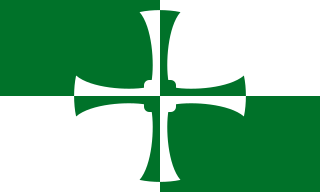
Kirkcudbrightshire, or the County of Kirkcudbright or the Stewartry of Kirkcudbright, is a historic county, registration county and lieutenancy area in the informal Galloway area of south-western Scotland. For local government purposes, it forms part of the wider Dumfries and Galloway council area of which it forms a committee area under the name of the Stewartry.
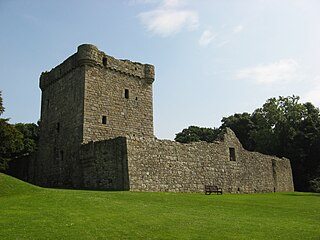
Lochleven Castle is a ruined castle on an island in Loch Leven, in the Perth and Kinross local authority area of Scotland. Possibly built around 1300, the castle was the site of military action during the Wars of Scottish Independence (1296–1357). In the latter part of the 14th century, the castle was granted to William Douglas, 1st Earl of Douglas, by his uncle. It remained in the Douglases' hands for the next 300 years. Mary, Queen of Scots, was imprisoned there in 1567–68, and forced to abdicate as queen, before escaping with the help of her gaoler's family. In 1588, the queen's gaoler inherited the title of Earl of Morton, and moved away from the castle. In 1675, Sir William Bruce, an architect, bought the castle and used it as a focal point for his garden; it was never again used as a residence.

Cardoness Castle is a well-preserved 15th-century tower house just south west of Gatehouse of Fleet, in the historical county of Kirkcudbrightshire in Scotland. It was originally owned by the MacCullochs of Myreton. They abandoned the castle in the late 17th century, following the execution of Sir Godfrey McCulloch for the murder of a Clan Gordon neighbour. It is now in the care of Historic Environment Scotland, and is a scheduled monument.

The Abbey of Saint Mary of Crossraguel is a ruin of a former abbey near the town of Maybole, South Ayrshire, Scotland. Although it is a ruin, visitors can still see the original monks’ church, their cloister and their dovecot.
The Battle of Glen Trool was a minor engagement in the First War of Scottish Independence, fought in April 1307. Glen Trool is a narrow glen in the Southern Uplands of Galloway, Scotland. Loch Trool is aligned on an east–west axis and is flanked on both sides by steep rising hills, making it ideal for an ambush. The battlefield is currently under research to be inventoried and protected by Historic Scotland under the Scottish Historical Environment Policy of 2009.

Threave Castle is situated on an island in the River Dee, 2.5 kilometres (1.6 mi) west of Castle Douglas in the historical county of Kirkcudbrightshire in the Dumfries and Galloway region of Scotland.

Crawford Castle, substantially in ruins, is located on the north bank of the River Clyde, around half a mile north of Crawford, South Lanarkshire, Scotland. The ruins stand on an earlier motte and bailey earthwork. The castle is also known as Lindsay Tower, after its former owners, the Lindsay family. The strategic location of the castle, at NS954213, guards the strategically important Mennock Pass from England into the upper Clyde Valley.
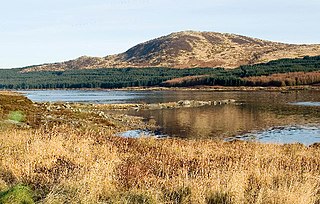
Loch Doon is a freshwater loch in Carrick, Scotland. The River Doon issues from its northern end, while the loch itself receives waters from Gala Lane and Loch Enoch via Eglin Lane.

Buittle is an ecclesiastical and civil parish in Dumfries and Galloway, southwest Scotland, in the traditional county of Kirkcudbrightshire. It lies to the west of the Urr Water, between Dalbeattie and Castle Douglas, and extends from Haugh of Urr in the north to Almorness Point on the Solway Firth in the south. The main settlement is the small village of Palnackie.

Morton Castle is located by an artificial loch in the hills above Nithsdale, in Dumfries and Galloway, south-west Scotland. It lies 2.5 miles (4 km) north-east of Thornhill, and once formed part of a chain of castles along the strategically important Nith Valley, which runs from the Solway Firth north to the Clyde Valley.

Lincluden Collegiate Church, known earlier as Lincluden Priory or Lincluden Abbey, is a ruined religious house, situated in the historic county of Kirkcudbrightshire and to the north of the Royal Burgh of Dumfries, Scotland. Situated in a bend of the Cluden Water, at its confluence with the River Nith, the ruins are on the site of the Bailey of the very early Lincluden Castle, as are those of the later Lincluden Tower. This religious house was founded circa 1160 and was used for various purposes, until its abandonment around 1700. The remaining ruins are protected as a scheduled monument.

Carrick Castle is a 14th-century tower house on the west shore of Loch Goil on the Cowal peninsula in Argyll and Bute, Scotland. It is located between Cuilmuich and Carrick, 4 miles (6.4 km) south of Lochgoilhead.
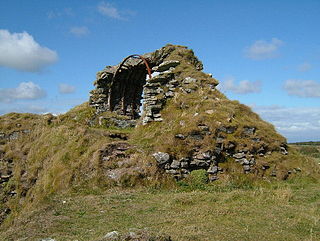
Cruggleton Castle is a multi-period archaeological site on the coast of the Machars, in the historical county of Wigtownshire in south-west Scotland. It is located at Cruggleton Point, around 4.5 kilometres (2.8 mi) east of Whithorn and 6 kilometres (3.7 mi) south-east of Sorbie. Excavations in the 1970s and 1980s revealed several periods of use, from the 1st century AD to the 17th century. The first stone tower was built in the 13th century, on an earlier motte.
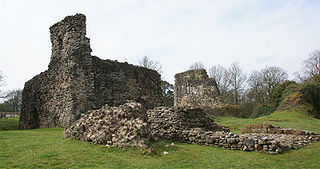
Lochmaben Castle is a ruined castle in the town of Lochmaben, the feudal Lordship of Annandale, and the united county of Dumfries and Galloway. It was built by Edward I in the 14th century replacing an earlier motte and bailey castle, and later rebuilt during the reign of James IV of Scotland. The earlier motte-and-bailey castle was built south of the current castle in c. 1160 by the Bruce family, Lords of Annandale.

Blanerne Castle is the remains of a 16th-century fortified house, located in the grounds of Blanerne House, an 18th-century country house between Chirnside and Preston in the Scottish Borders. The house and castle sit on the north bank of the Whiteadder Water, around 6 kilometres (3.7 mi) north-east of Duns.
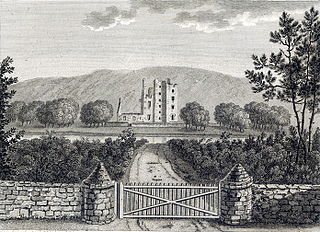
Castle Kennedy is a small village 3 miles (4.8 km) east of Stranraer in Dumfries and Galloway, south-west Scotland. It is on the A75 road, and is within the civil parish of Inch. The village is to the south of the Lochinch Castle estate, which includes the ruins of the 17th-century Castle Kennedy, as well as Castle Kennedy Gardens which are open to the public.
Leswalt is a village and civil parish in Dumfries and Galloway, south-west Scotland. It lies between Portpatrick and Stranraer in the Rhins of Galloway, part of the traditional county of Wigtownshire. The parish covers around 8 square miles (21 km2).

Kerse Castle or Carse Castle is a ruined fortification once held by the Craufurd Clan, situated in the Parish of Dalrymple, East Ayrshire, Scotland.

Buittle Castle, also known historically as Botle or Botel Castle, is a Motte and Bailey site in Galloway, south-west Scotland with significant early and medieval history comprising a significant ruined Norman style Motte, and several extant buildings and gardens, including the later residential building in the form of the Tower House, on the historic Bailey. It is located in the valley of the River Urr, 1 kilometre (0.62 mi) west of Dalbeattie. The castle is within the parish of Buittle, in the traditional county of Kirkcudbrightshire and is a scheduled ancient monument.

Kenmure Castle is a fortified house or castle in The Glenkens, 1 mile (1.6 km) south of the town of New Galloway in Kirkcudbrightshire, Galloway, south-west Scotland. The site was occupied from the Middle Ages, and the house incorporates part of a 17th-century castle. This was remodelled in the 19th century, but the house has been derelict since the mid-20th century. It was the seat of the Gordon family of Lochinvar, later raised to the peerage as Viscounts of Kenmure. The ruin is a scheduled monument.